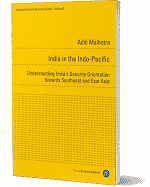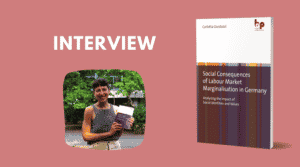 New with Budrich:
New with Budrich:
by Aditi Malhotra
About the book
In view of the fast-changing world order, emerging countries are increasingly influencing the dynamics of regional securities. This timely and in-depth book examines India’s reorienting strategic posture and describes how New Delhi’s security policy in the Indo-Pacific region has evolved and expanded over the past two decades. The author argues that India’s quest to leverage its geostrategic location to emerge as an Indo-Pacific actor faces multiple challenges, which create a clear divide between the country’s political rhetoric and action on the ground. The author critically examines these contradictions to better situate India’s security role in an increasingly fluid Indo-Pacific region.
Dear Aditi Malhotra, in your book you examine India’s reorienting strategic posture and describe how New Delhi’s security policy in the Indo-Pacific region has evolved. Which questions do you exactly tackle?
When I began my research on the book, I was initially interested in exploring if India’s security conduct in the Indo-Pacific was primarily driven by its desire to balance China in the region. However, as I dug deeper, I realised that India’s security policy actions were not always in line with what would be expected from a power balancing China in the Indo-Pacific, specifically in Southeast and East Asia. As a result, my research questions changed. The book tackles the central question: Why is India expanding its security relations with countries in Southeast Asia and East Asia? When answering this question, the book also looks at the internal and external factors responsible for India’s evolving security role in the broader region. It also explains why a gap exists between India’s rhetoric and on-the-actions in the security domain.
Could you say something more about your conceptual framework?
In the book, I have developed the conceptual framework of role theory. Role theory explains a country’s policy behaviour through the unit of role conception. This means that countries tend to have conceptions of their role within the international system. For instance, some countries view themselves as peacekeepers, security providers, system challengers, etc. While some roles remain intact over years or decades, others evolve over time or change due to drastic and sudden developments.
In the book, I utilise the variable to role conception to showcase India’s security role in the Asia-Pacific/Indo-Pacific region has evolved over the last two decades. The conceptual framework also identifies domestic and international factors that lead to this role evolution. This is where I study the exogenous and endogenous variables responsible for the expansion of India’s security roles in recent decades. Finally, the conceptual framework highlights the discrepancies in a country’s declared role and its on-the-ground actions. Using this correlation, I was able to underline that India’s political rhetoric may not always be reflected in its actions. This gap is mainly due to the confluence of internal and external inhibiting factors that are detailed in the book. Overall, the conceptual framework helped offer a comprehensive overview and understanding of a state’s policy behaviour and its determinants.
How did you develop the subject of your project?
I began by doing a detailed review of all Indian foreign policy speeches from the year 2001 to December 2020. From all the speeches that covered the region of Asia-Pacific/Indo-Pacific, I was able to identify the most prominent and repeated self-defined roles. The identified role conceptions were India as a major power, net security provider, leading power and stakeholder in the security and stability of the Indo-Pacific. As evident in the speeches, these roles did not change overnight but evolved incrementally over the years.
To do justice to the nuance of role evolution and its process, I relied heavily on the literature on role theory to form a conceptual framework. I used the relevant conceptual blocks and established their correlations to explain the process of role evolution comprehensively. Once the conceptual framework was ready, I used it to study the case of India’s security policy conduct in the Indo-Pacific.
Are there any findings that surprised you or that might surprise your readers?
To be candid, a lot of things surprised me. Before this study, I considered myself a proponent of the International Relations theory of realism. Most of the previous work drew heavily from the theory, so my initial preference was to apply the theory of realism to explain India’s balancing behaviour. However, upon looking at the empirical data, I realised that India was not really ‘balancing’ China in the classical sense. This is what compelled me to look for more non-traditional theories. As I explored new theories, I was surprised by how non-systemic factors provided answers to some of the seeming discrepancies in India’s security behaviour.
As a researcher, it surprised me that many of us fall into the trap of traditional theories that have a predominant preference for systemic or structural factors. In the book, there is greater nuance, which highlights that while systemic factors are crucial to grasping a country’s external security disposition (as covered in detail), there are equally important determinants at the domestic levels. These domestic factors can sometimes act as a facilitator, while in some cases, they can end up inhibiting the trajectory of a country’s security policy. In the book, some readers may be surprised to see the facilitating role that the Indian Navy has played in expanding India’s maritime role in the region. At the same time, some would find it interesting to note how the combination of the civil-military divide, the dilemma between continental and maritime priorities, and turf wars at the domestic levels affect India’s security conduct.
You argue that even as India’s security role has evolved, New Delhi has not been able to implement them in action effectively. What are some of the reasons for this?
India faces a combination of constraining factors at the domestic and international levels. Due to their combined influence, India’s security policy statement is not reflected in its policy actions. Some reasons include the dilemma of earmarking finite resources towards competing priorities (developmental needs vs security) and contestations between state institutions (civil-military divide and turf wars). Concurrently, the Indian planners grapple with the demands of continental and maritime security needs, made more complex in the backdrop of limited defence budgets.
On the international front, India faces the challenge of balancing its interaction with a range of countries, some of which do not share very cordial relations. For instance, on the one front, New Delhi engages the US and its allies in many formats, including the Quad arrangement and trilateral dialogues. On the other front, it engages countries such as Russia and China in formats including the SCO and Russia-India-China trilateral. Interestingly, even as India and China have substantial areas of divergences and compete in overlapping geographical areas, there are some areas of cooperation as well. Similarly, with countries including the US and its allies in the Indo-Pacific, India has many commonalities and shared interests but also experiences some differences. As a result of what is termed the convergence-divergence dynamics, India’s external relations remain complex and limit the policy choices that India displays at different points in time. The cumulative effect of inhibiting variables in the internal and external domain certainly creates a gap between India’s claimed security roles and policy actions.
Short vita in own words
 I recently joined the Canadian Army Journal as the Editor in Chief. Before this, I was the co-editor for the Co-Editor for the Journal for Intelligence, Propaganda and Security Studies (Graz, Austria). In addition to my latest book, India in the Indo-Pacific, I am looking forward to the release of my next book late this year, which explores the changing trend in contemporary international security through the case studies of the US, China and India.
I recently joined the Canadian Army Journal as the Editor in Chief. Before this, I was the co-editor for the Co-Editor for the Journal for Intelligence, Propaganda and Security Studies (Graz, Austria). In addition to my latest book, India in the Indo-Pacific, I am looking forward to the release of my next book late this year, which explores the changing trend in contemporary international security through the case studies of the US, China and India.

Order now via our shop or download the Open Access publication
by Aditi Malhotra

